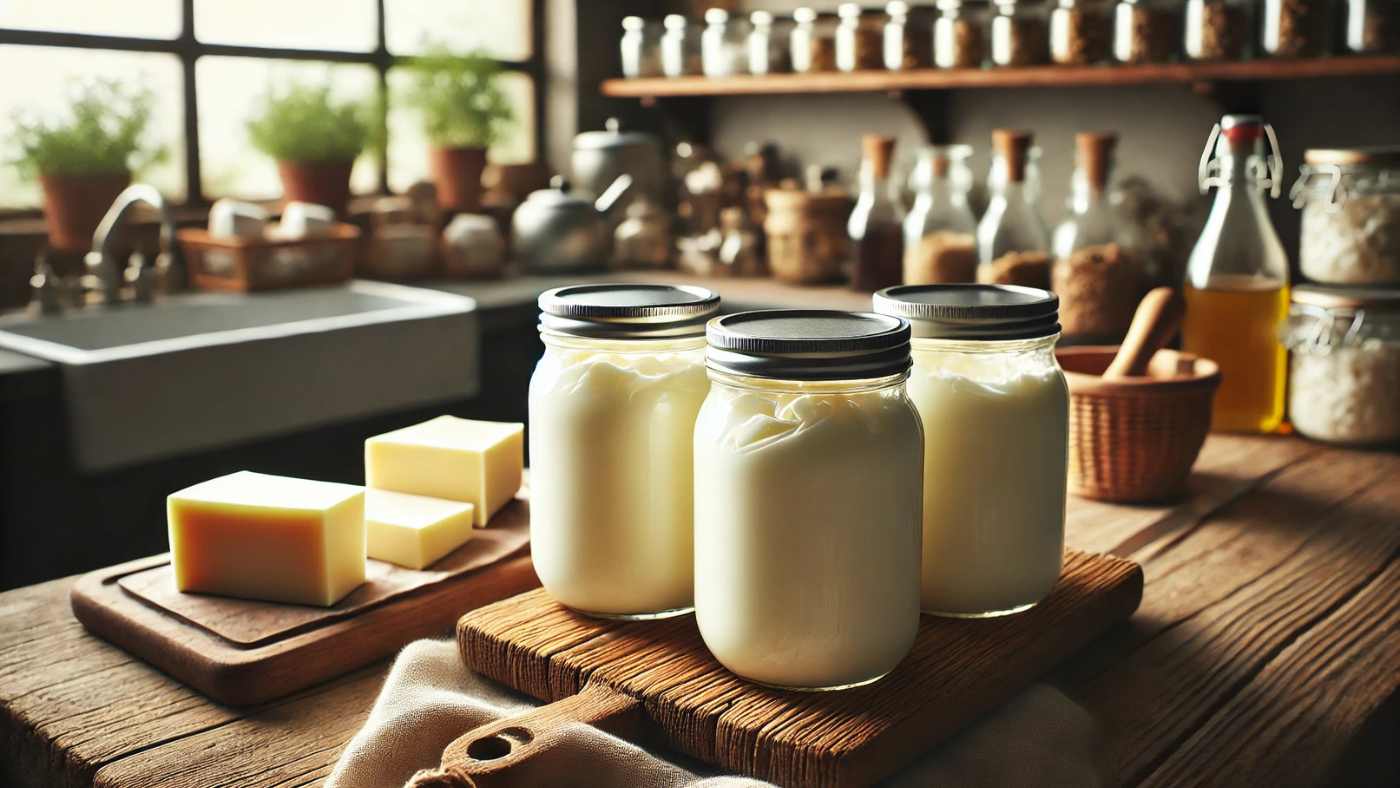How to Store Beef Tallow: Tips to Keep It Fresh and Safe

Beef tallow is an excellent fat with a long history of use in cooking and skincare.
Beef tallow is known for its high smoke point and rich flavor, and it has become a favorite of those who seek natural, healthy fat in their diet.
However, you need to store it properly in order to get the best quality.
Beef tallow can last a long time if stored correctly without going bad.
You have proper storage, which keeps it fresh, prevents it from going rancid, and ensures you have it when needed.
In this guide, we’ll walk you through everything you need to know about storing beef tallow safely.
Why You Should Care About Beef Tallow Storage
For a few reasons, storing beef tallow correctly is essential.
First, it extends the shelf life so you can keep your tallow fresh for months, sometimes even longer.
Good storage practices also help preserve tallow's nutritional and flavor benefits, including the vitamins A, D, E, and K (1).
Finally, proper storage prevents harmful bacteria and mold from contaminating the tallow.
With the right steps, you can save waste and get the most out of every batch.
How to Keep Beef Tallow at Room Temperature
Following some rules, beef tallow can be stored at room temperature.
This method is good for short-term storage of tallow, but it should be kept in an environment that will maintain its quality.
The Best Containers for Beef Tallow Storage
If you store beef tallow at room temperature, you want airtight containers that don’t react with fat, like glass or stainless steel.
Glass jars are a great option because they are non-reactive, easy to clean, and don’t absorb odors.
Another option is to use a stainless steel container with a tightly sealed lid to keep out the moisture and air that can make the tallow go bad.
If possible, avoid plastic containers that can absorb the fat and give your food an unwanted taste over time.

Shelf Stable Storage Best Practices
Keep beef tallow in a cool, dark place to store it safely at room temperature.
If you don’t have extreme temperature changes, your pantry or cabinet will do just fine.
Direct sunlight can accelerate the spoilage process, so your storage space should be away from direct sunlight or light (2).
Beef tallow can last up to six months at room temperature in a tightly sealed container.
But, check it occasionally to see if it has any off smells or weird texture.
Beef Tallow Refrigeration for Extended Shelf Life
Keeping beef tallow fresh longer is best done by refrigerating it.
It can also help prevent rancidity and maintain the beneficial properties of the tallow.
Reasons Why Refrigeration is Recommended for Long-Term Storage
Beef tallow solidifies in the fridge and is less exposed to oxygen and light.
It slows down the oxidation process, which makes fat go bad over time (3).
Refrigeration is best if you use tallow occasionally, as it will preserve the tallow for months without spoiling.

How Long Beef Tallow Stays Fresh in the Fridge
If you store beef tallow in the refrigerator in an airtight container, it will stay fresh for up to a year.
Seal the container tightly to keep any odors from other foods from leaching into the tallow.
You can just scoop out the amount you need and return the container to the fridge when you’re ready to use it.
Tallow that develops a sour smell or changes color is a sign that it may be time to dump it.
Freezing Beef Tallow for Long Term Preservation
Long-term storage is the best way to store beef tallow because it freezes well and will keep for years without affecting quality (4).
If you’ve made a big batch, this is the best way to use it sparingly.
How to Properly Freeze Beef Tallow
Break the tallow into manageable portion sizes so that you can thaw only what you will need.
Freezing tallow in small portions is a convenient way to do it when you have ice cube trays or silicone molds.
After putting the cubes in a freezer-safe bag or container, freeze them for one time.
You can freeze larger portions by putting the tallow in a freezer-safe container or resealable bag.
Press this out to reduce the risk of freezer burn.
Write the date you froze the container on it so you can tell how long it’s been in the freezer.
Frozen Beef Tallow Shelf Life
If you keep frozen beef tallow at a constant freezing temperature, it will last indefinitely.
Although it will still be usable after that time, for best quality, you should use it within one to two years.
So when you are ready to use frozen tallow, let it thaw in the fridge or at room temp.
Don’t microwave it directly, as high heat will degrade the quality.

How to Recognize Signs That Beef Tallow is Bad
Beef tallow can go bad even with proper storage. You can avoid using rancid tallow if you know the signs of spoilage.
Beef Tallow Is Rancid: How to Tell
Rancid tallow normally has a sour, unpleasant smell (5).
Sometimes, a sign of spoilage is if the tallow has turned yellow or has a grainy texture.
If you don’t know what to do, trust your senses.
Tallow has a clean, neutral smell and a smooth, creamy texture, works well as a sealant, and it's cheap.
What to Do with Old or Bad Beef Tallow
Throw away your beef tallow carefully if it’s gone bad.
Don’t dump it down the drain, or it can solidify and clog pipes.
Instead, scoop the tallow into a container or plastic bag and throw it out in the trash.
It helps you avoid damage to your plumbing and safely gets rid of rancid fat from your kitchen.
FAQs
Is beef tallow supposed to be refrigerated?
You don’t need to refrigerate it, but it will last much longer if you do not use it frequently.
How long can you store beef tallow unrefrigerated?
Beef tallow can be kept for up to six months at room temperature if kept in an airtight container in a cold, dark location.
Can I reuse beef tallow after I’ve tried it?
Frying beef tallow is fine, but you should strain it and store it in the fridge so that it stays fresh.
What is the best container to store beef tallow?
Beef tallow is best stored in glass jars or stainless steel containers, which are non-reactive and easy to clean.
What can I do with my stored beef tallow in skincare?
Warm a small amount in your hands and then apply. A natural moisturizer that can be used on most skin types is beef tallow.
Final Thoughts
If stored properly, beef tallow is a valuable, nutrient-rich fat that you should get the most out of.
Using a suitable container and storage method, you can keep it fresh and safe to use for months or even years.
No matter what you choose to do with it, whether you store it at room temperature or put it in the fridge or freezer, these simple steps will help you get quality beef tallow when you need it.
If you’re not already taking advantage of this healthy fat’s natural benefits, consider adding it to your cooking or skincare routine, but remember, proper storage is key to keeping it around.
🐄 Bring Back Real, Nutritious Fats! Enhance Your Meals with Beef Tallow! 🐄
Related Studies
1. Title: Effect of dietary fat and vitamin E on color stability and on lipid and protein oxidation
This study investigates how dietary fats, including beef tallow, influence the stability of fat-soluble vitamins during refrigerated storage.
Link: https://pubmed.ncbi.nlm.nih.gov/22063078/
2. Title: Beef Tallow Consumption and Health
The article discusses how proper storage conditions can maintain the quality of beef tallow for up to six months, emphasizing the effects of light exposure on rancidity rates.
Link: https://he02.tci-thaijo.org/index.php/jcra/article/view/222030
3. Title: Impact of storage conditions and premix type on fat-soluble vitamin stability
The research examines how different storage conditions affect the stability of fat-soluble vitamins A, D, and E in fats, demonstrating that refrigeration can enhance their preservation.
Link: https://academic.oup.com/tas/article/4/3/txaa143/5885173
4. Title: The effect of freezing storage on physical and chemical properties of wild boar meat
This study finds that freezing does not negatively impact the quality of animal fats, indicating that freezing beef tallow can preserve its usability and nutritional content for extended periods.
Link: https://cjfs.agriculturejournals.cz/artkey/cjf-201806-0008_the-effect-of-freezing-storage-on-physical-and-chemical-properties-of-wild-boar-meat.php
5. Title: Effect of storage temperature on lipid oxidation and changes in nutrient contents
This research highlights how changes in smell, color, and texture correlate with lipid oxidation in fats, providing indicators for detecting rancidity in stored fats like beef tallow.
Link: https://pmc.ncbi.nlm.nih.gov/articles/PMC6657719/

